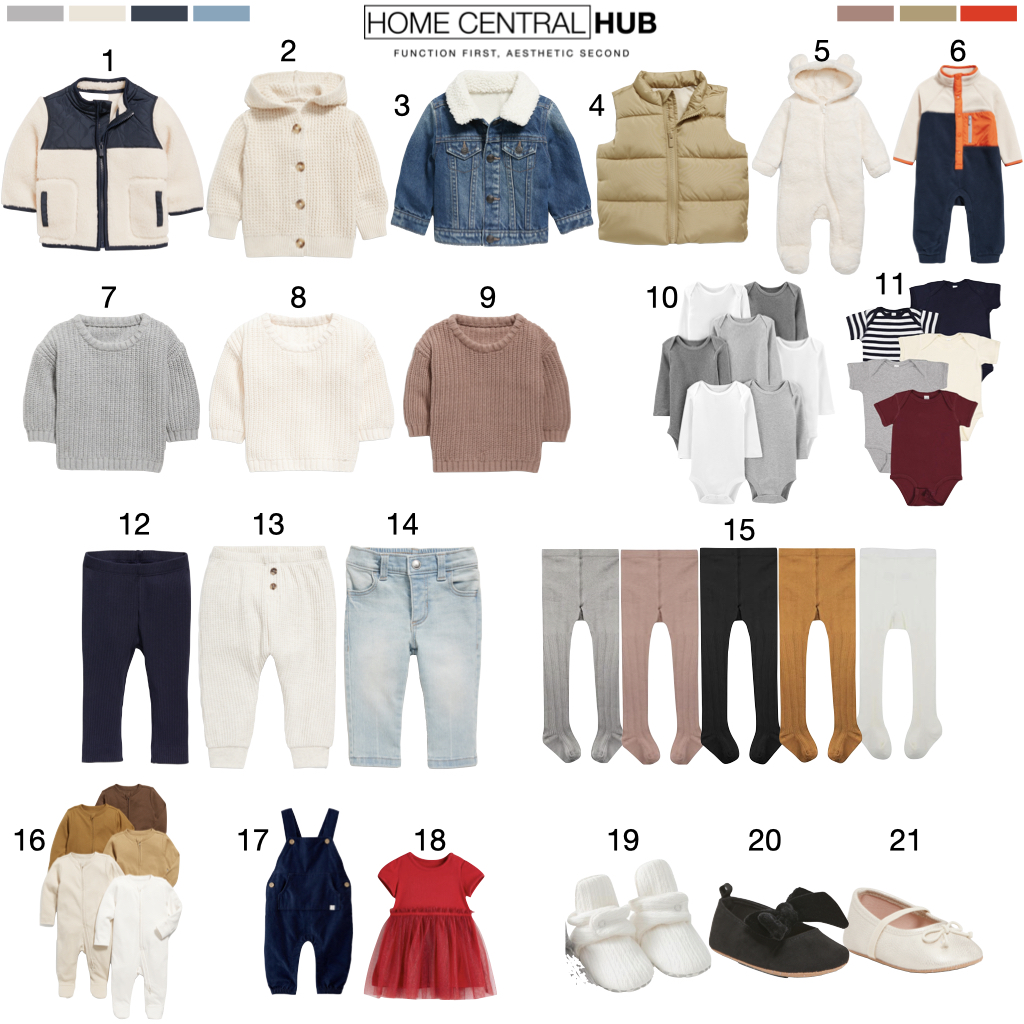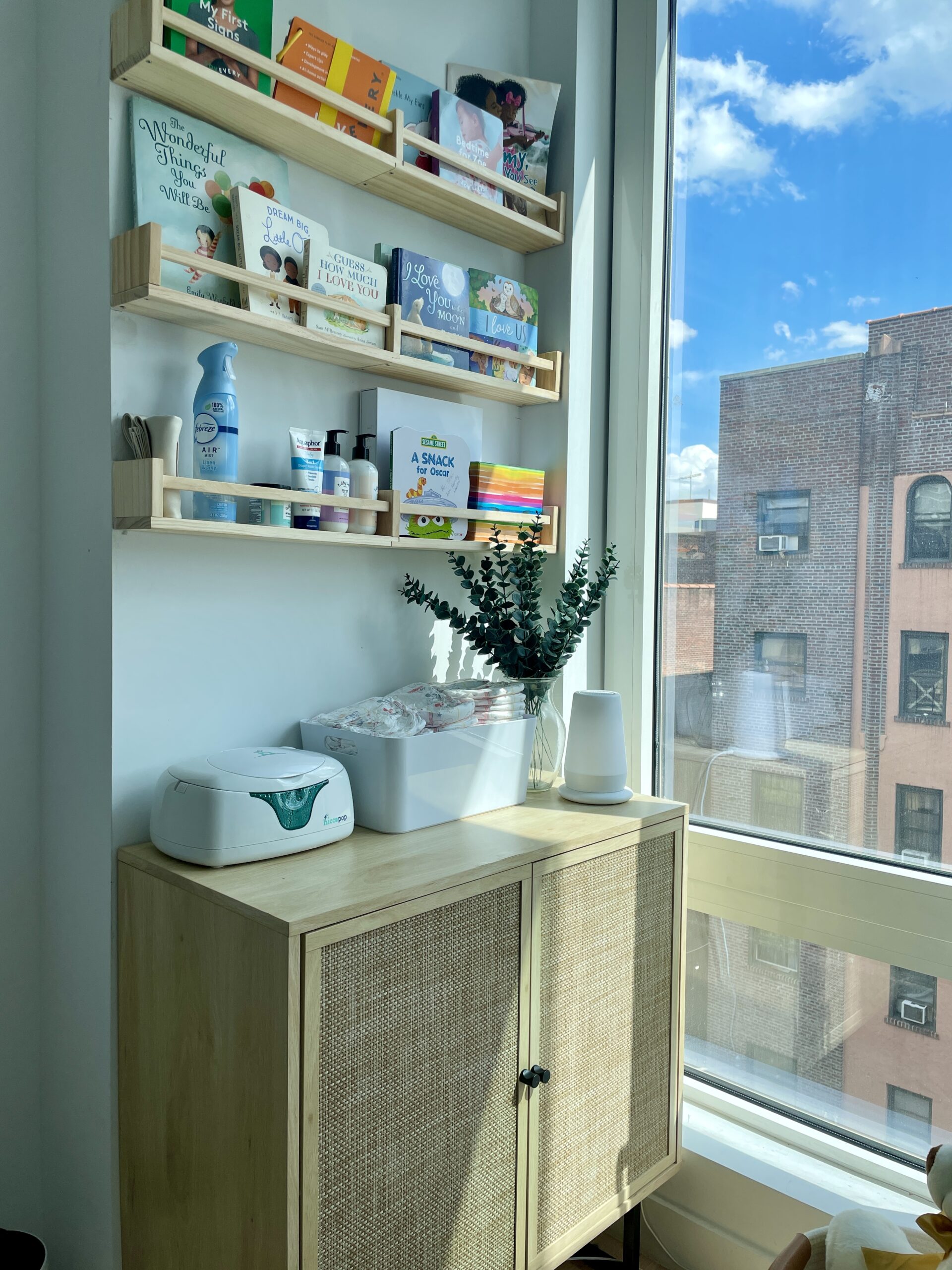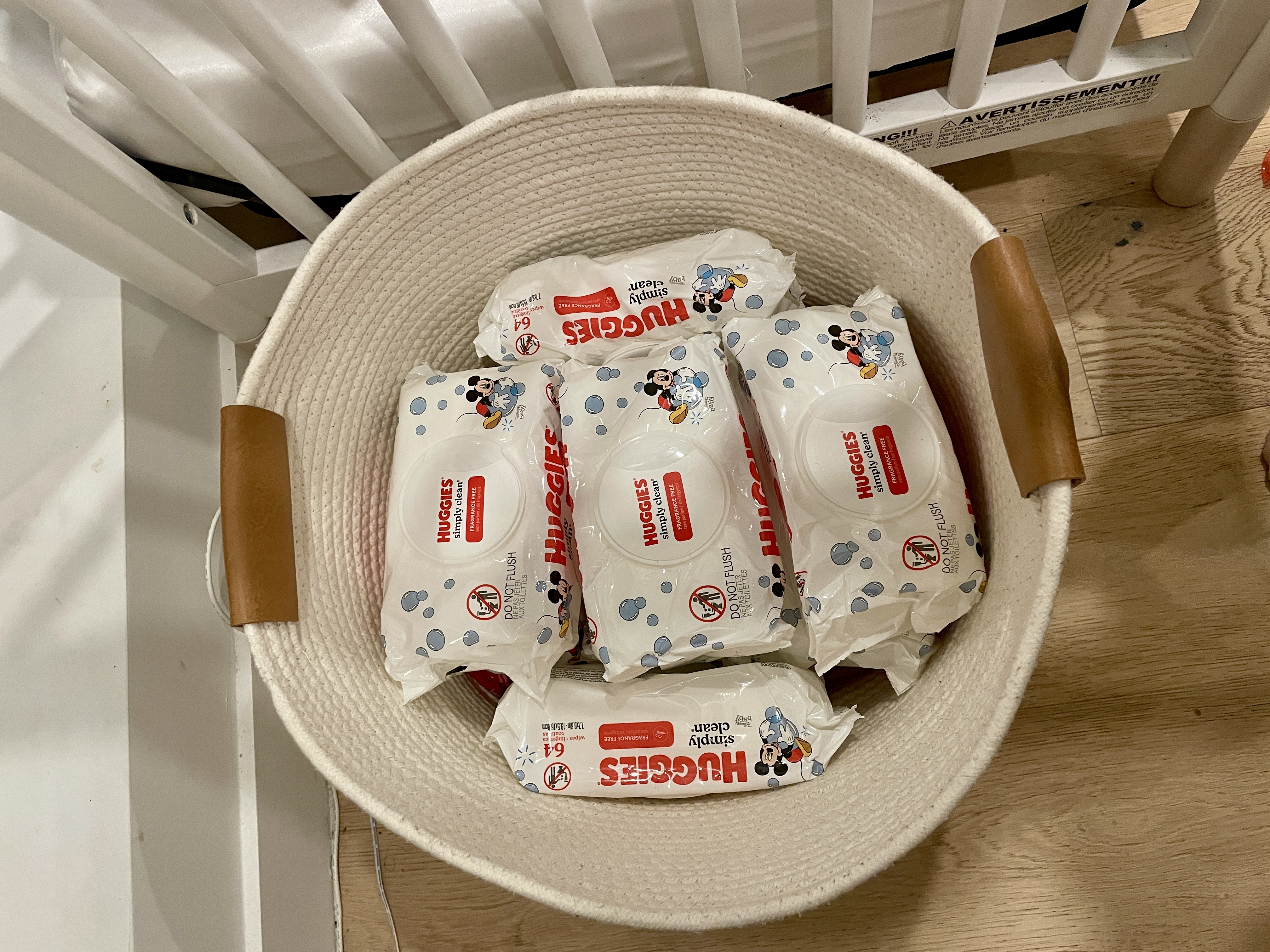This site uses affiliate marketing, please read our disclaimer policy for more information

This blog post is for you if you’re sharing a room with your baby. Chances are you’re short on space. Chances are you’re overwhelmed by the amount of stuff that needs storing and not having enough space to store it. It’s nerve-wracking and stress inducing. And being a parent, you know that no matter how minimalistic you are, children simply have too many stuff.
Remember, living in a small space doesn’t have to be chaotic. It simply requires you to shop more intentionally. Otherwise, your home will feel cluttered and disorganized.
In this blog post
Learn how to organize the following in a shared (small) nursery.
- Clothing and accessories
- Personal care and health
- Toys and books
- Bedding and textiles
- Products (stockpile)
- Memorabilia
Clothing and Accessories
Organization Challenges
- Too many clothing and not enough space



Plan and Recommendations
- Decreased the number of clothing your child has. If your child is 6 months or less, my number one recommendation is to buy only one size up. In my experience, I’ve found that having only one additional size is all that is needed. It offers you enough coverage for when your little one is now beginning to outgrow his/her current size. Yet, relieves you of the stress and urgency to buy.
- Use smart storage options for your specific space. If your child is older than 6 months, my number one recommendation to managing his/her closet and maintaining a clutter-free space is to adopt a capsule wardrobe system. At this age, babies typically fall into a routine of sleeping/waking and eating/playing. This added predictability in your day gives you more time for cute outfits (if you desire). Having a collection of clothes that pairs well together will eliminate your need for a lot of clothing. Therefore, decreasing the chances of cluttered.
Take a look at one of the capsule wardrobes that I’ve created for my daughter.

Storage Solutions
- A dresser or cabinet. For a shared nursery, a dresser or a cabinet with adjustable shelving like the Kova Sideboard, is great for storing baby clothing. While the numerous drawer and large surface of a dresser is enough to create a changing station and hold everything from socks to outerwear; the openness and adjustable shelving of a cabinet gives you versatility.
- A Standalone Wardrobe. If your space can accommodate a standalone wardrobe, like the IKEA PAX, then consider yourself fortunate.
- Floating Shelves. Floating shelves are great for shared (small) nurseries because it lets you use up vertical spaces rather than floor spaces. It can create a standalone wardrobe feel if done correctly and used in conjunction with a clothing rod.
- Bins and Baskets. Storage bins and baskets are wonderful for concealing messiness, categorizing items, and showcasing
- Storage Cases. Storage cases that fits under your crib is great for maximizing space. It’s a great place to store anything that’s not used on a daily basis. Items such as, beddings or off season clothing.
Personal Care and Health
Organization Challenges
- Items aren’t used enough to justify storing (yet too valuable to not have on hand)

Plan and Recommendations
- Store everything in a storage bin. Storing personal care items and medications for a child is a mental battle. On one hand, you don’t ever want to be without cold & cough medications, gas treatment, or the suction machine. While on the other hand, you would rather not take up valuable space with items that you uses very rarely.
- Create a first aid kit. A first aid kit is hands down the better of the two option because it creates a designated setup in case of emergency. Also, you’re able to store all of your household medications and emery supplies in one kit.
Storage Solutions
- Storage bins. You have many options available to you. You can buy storage bins with or without dividers, transparent or opaque, stackable or regular.
- First aid kit. You can buy the premade kits that comes with everything in it. However, I recommend buying an empty kit and filling it yourselves. Oftentime, the premade kits don’t have an equal distribution of supplies. You often find yourselves with too many band-aids and alcohol pads.
- Stackable bins or drawer organizers. This is my favorite method of organizing personal care and health items. It’s perfect for easy visualization and access. And it allows you to truly categorize your items. Not to mention, the transparent bins and organizer is appealing and complement any decor style.
Toys and Books
Organization Challenges
- Too many toys and not enough space
- No place to store books


Plan and Recommendations
- Return items that you either don’t completely love or finds entirely useful. Reserve storage for only items you absolutely love or that adds value to your life. If you’re 50/50 on an item, return it and find an alternative that you’re 100% sure on.
- Store or sell items that your child has developmentally outgrew. There’s no use in holding onto a play mat or a rolling walker when your child is a busy toddler and professional walker. Store the item away for another child or sell it online. I personally invested in a small storage unit for $20 monthly.
- Use a sideboard, dresser, or entryway cabinet as your media stand. While a designated TV stand is for storing the bare minimum, these furniture types lets you store any and everything, from books, to office supplies, to board games and toys.
- Utilize vertical space. Install floating shelves or a wall mounted bookshelf in a corner of your bedroom or above the dresser or cabinet for a more intentional look.

Storage Solutions
- TV stand alternatives. Rationale is to maximize storage.
- Wall mounted bookshelf. Rationale is to limit usage of floor spacing, which decreases visual clutter. A wall mounted bookshelf maximizes storage by using vertical space.
Bedding and Textiles
Organization Challenges
- No designated linen closet
- No place to store bedding

Plan and Recommendations
- Limit the number of bedding. Ideally, you really only need 3 bedding set for your child. However, this number will also depends on how often you do laundry and how often you change bedding. Nonetheless, 3 bedding set is enough even if you do laundry every 2-3 weeks or change bedding weekly.
- Change bedding only once per week. There’s really no need to change your child’s bedding more than once a week or once every two weeks unless an accident occurred.
- Utilized hidden storage. In a small space, minimizing visual cluttered is key to having a nice space. Store unused linen in storages cases and slide them under the bed or crib. This is great because it gives you easy access while being out of reach.
Storage Solutions
- Storage Cases. Storage cases are great for sliding under the crib or bed, which are empty spaces that’s typically go unused.
- Decorative storage Baskets. If you value convenience more than anything, then a lovely storage basket on the ground can also function as storage for your little one’s bedding and textiles. This eliminates the need to slide in and out a storage case. Just make sure to fold everything neatly and also, buy a storage basket large enough so it doesn’t look overflowing.
Products (stockpile)
Organization Challenges
- Too many products and not enough space
- Lack of a utility/linen closet
- Lack of bathroom vanity storage

Plan and Recommendations
- Limit your number of stockpile products. Do we really need a 3 month supply of diapers and wipes? Or 6 diaper rash creams? I guarantee you the answer is no. Unless the item is on sale and you’re getting like 50% off, I advice you to buy less but be aware of when your favorite brands typically have sales. I found that having no more than 2 stockpile per item is enough (even one can do). It’s enough coverage for when you run out of the first bottle (1 out of 3), yet it provides you with enough time to restock. The problem with only have 1 stockpile item is that there’s no wiggle room if you finished the last bottle and forgot to re-order. If you’re anything like me, who takes a week to order detergent or groceries, then opt to have 2 extra on hand.
- Create changing stations throughout home. Some of you may find this as an odd suggest for controlling stockpile products in a small space. So let me explain. Having one changing station in your bedroom and one in your living room splits your products into twos. This means that you have the same number of products but less in need of actual storage (stockpile). For instance, I have a changing station with diapers, wipes, diaper rash cream, and lotion in my bedroom and living room. While the products in my bedroom is used more heavily, the living room one acts as a secondary station for when we’re all in the living room or when my husband or I is sleeping in the bedroom. This is a win-win setup because it gives you convenience, have less products to store, and decreases disturbance for alone time (which is crucial in a apartment living).
Storage Solutions
- Utilized storage bins in a cabinet or a drawer of a dresser. The simplest solution to not having a place for products is to use storage bins in a cabinet, on a shelf, or on the floor. Likewise, to use drawer dividers in a dresser. For storing products, we recommend a hard plastic material due to its durability and ease of cleaning in the event that something were to spill.
- Utilized a standalone drawer cabinet in the bathroom. Products similar to the container store’s Elfa Drawer Cabinet is great for creating a makeshift storage in absence of a linen/utility closet.
- Utilized a door mounted shelf system. Products similar to the container store’s Elfa Utility Over the Door Rack is great because it satisfies your complete need for product storage. This alone can replace your need for a utility closet. You’ll be able to store products for the entire household.
Memorabilia
- Pregnancy sonograms
- Newborn footprints
- Hospital bands
- Umbilical cord
Organization Challenges
- Difficult to organize in a decorative manner
- Various form (shapes) makes it difficult to display as a single unit
Plan and Recommendations
- Use smart storage options for your specific space
- Utilize vertical space
Storage Solutions
- Picture frames. Frame your sonograms, newborn footprints and ID bands to display on the wall, floating shelves, or dresser/cabinet of your nursery. Pro tip: digitalized your items by scanning them into computer. This route gives you more artistic control in the color/style of the items. This is the route if you prefers a more cohesive look.
- Memory chest box. Ideal for those of you that prefers a vintage flair. There’s sentiment in a traditional memory chest, which you can pack and unpack with your child. I personally have a chest box of items from my childhood and my teenage years.
- Decorative storage boxes. Decorative storage boxes are ideal for those of you who prefers a more modern alternative to the vintage memory chest box. There are great for storing any and everything from sonograms to the umbilical cord. The only drawback (or positive depending on your preference) is that your items are not on displayed.
I hope you this blog post empowered you to tactile your nursery dilemma.
The Takeaway
The most important thing you can do to stay organized in a small space is to buy the bare minimum. Equally important, is to understand the flow of your space and to use organizers best suited for that space. Having a small home doesn’t mean you have to sacrifice function or aesthetics.

Join our Mailing List
Sign up with us now and be the first one to know about our exclusive offers and product updates.


